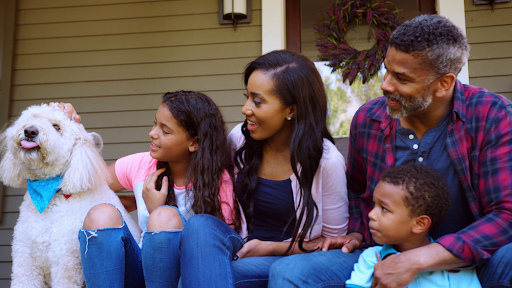
Owning a dog can be an incredibly rewarding experience for a family, especially for children. It not only brings companionship but also teaches valuable life lessons. In this article, we delve into the essential aspects every parent should consider when preparing their child for the responsibilities of owning a dog.
Choose the Right Dog for Your Family
When choosing a dog, it's important to consider your family's lifestyle and the space available in your home. Smaller breeds may be better suited to apartment living, while larger breeds often need more space to roam. Additionally, it's crucial to consider the dog's temperament, especially with children in the house, to ensure a harmonious environment.
About 2.2 million dogs were adopted in 2023, indicating a growing interest in pet ownership. This trend reflects an increasing number of families embracing the joy and responsibilities of having a dog. The choice to adopt should be informed by research and understanding of the commitment it entails.
Involving children in the selection process can be educational, teaching them about the diversity of dog breeds and their individual needs. This interaction encourages children to take part in the decision-making process and helps them build a connection with their new pet. Ultimately, finding the right dog sets the foundation for a lasting relationship and successful dog ownership.
Understand the Basic Needs of a Dog
Understanding a dog's basic needs is paramount to providing a nurturing environment in which they can thrive. These needs include love, attention, and regular veterinary care to ensure their wellbeing. Educating children about these responsibilities helps them appreciate the commitment required to care for their pet.
Routine visits to the veterinarian are essential for preventative care, such as vaccinations and health check-ups. This practice helps protect not only the dog but also the family from transmittable diseases. Involving children in these visits can teach them the importance of health maintenance and responsibility.
Dogs also require a safe and comfortable living space. Designating specific areas for activities such as resting and eating helps create a structured environment. Encouraging children to participate in setting up these areas fosters a sense of responsibility and pride in caring for their new friend.
Define a Proper Nutrition and Feeding Schedule
Proper nutrition is a critical component of dog ownership, significantly influencing their overall health and happiness. Developing a feeding schedule ensures that dogs receive the necessary nutrients consistently. This regimen promotes discipline and routine, aspects beneficial to the pet and family alike.
The United States' pet owners spent the most globally, with a per capita expenditure of $162, emphasizing the financial commitment required for pet ownership. Parents should educate children about choosing quality pet food and how it affects their dog's health. Such discussions can instill an understanding of the importance of nutrition in supporting a pet's wellbeing.
Incorporating children in the feeding process can teach responsibility and time management. Assigning age-appropriate tasks, such as measuring portions or refilling water dishes, offers practical lessons in caring for another being. As children learn these tasks, they contribute positively to their dog's health and form deeper bonds with their pet.
Consider Regular Exercise and Playtime
Exercise and play are vital components of a dog's daily routine, necessary for their physical and mental health. Regular physical activity helps maintain a healthy weight while preventing boredom-related behaviors. Parents should instill the habit of exercise within their family routines, benefiting both the dog and their children.
Children can learn about the benefits of active living through playtime with their dog. Activities such as walks, fetch, or agility exercises provide a fun way to integrate physical activity into the day. By participating in these activities, children discover the importance of regular exercise in maintaining overall health and happiness.
Parents can also use exercise time as an opportunity to teach children responsibility in safety, such as using leashes and paying attention to their surroundings. Emphasizing these safety measures protects both the dog and child during outdoor activities. Ultimately, making exercise a family affair encourages a lifelong habit of physical wellness and bonding.
Allocate Age-Appropriate Duties for Children
Assigning age-appropriate responsibilities to children fosters a sense of independence and accountability. Younger children can take on simpler tasks such as brushing or feeding the dog, while older kids can handle more complex responsibilities like walking or basic training. These tasks enhance children's capacity to care for their pets, contributing to their development.
About 97% of pet owners regard their furry friends as family members, highlighting the deep bonds formed through interactions and caregiving. Parents should involve all family members in duties, creating a sense of shared responsibility. This involvement nurtures teamwork and understanding, reinforcing the fact that pet ownership is a family commitment.
Responsibilities should be taught gradually, allowing children to learn and grow into their roles confidently. Monitoring and guiding them during these tasks offers support and encouragement, promoting success. Furthermore, completing these duties instills pride and satisfaction, enriching the child's experience with their dog.
Teach Basic Commands and Obedience for Your New Dog
Teaching dogs basic commands is an essential aspect of ensuring safety and harmony within the home. Commands such as sit, stay, and come are fundamental tools in maintaining control and promoting good behavior. Children can assist in this training, learning alongside their pets and enhancing their connection.
Effective training requires consistency and patience, valuable skills that children develop through practice. Parents can involve children by assigning them specific commands to teach or rewarding successful demonstrations. This collaborative training experience fosters a shared sense of accomplishment among the family.
Using positive reinforcement techniques during training sessions can motivate both the dog and children. This method focuses on rewarding desired behaviors, thus encouraging continuous improvement. As children engage in training, they acquire valuable life skills, including communication, problem-solving, and patience.
Establishing Boundaries for Interaction
Establishing boundaries for interaction between children and their new dog is crucial for fostering a safe and respectful relationship. Teaching children to recognize a dog's body language aids in understanding when their pet is comfortable or needs space. This awareness promotes mutual respect and prevents potential incidents of stress or aggression.
Parents should communicate the importance of respecting a dog's space during activities such as eating or resting. Clear guidelines for interaction help children develop empathy and awareness. As they learn these boundaries, children contribute to creating a harmonious home environment.
Engaging in supervised play sessions allows parents to demonstrate appropriate interaction techniques. These sessions provide teachable moments, ensuring safe and positive experiences for both the child and dog. Understanding and respecting these boundaries ultimately nurtures a healthy and loving bond between them.
Preparing for dog ownership is a team effort that involves the whole family. By choosing the right dog, understanding their needs, engaging children in their care, training effectively, and ensuring safety, parents can foster a healthy and happy relationship between their child and their new furry friend. This preparation not only enriches the child’s life but also guarantees a fulfilling experience of dog ownership.


























